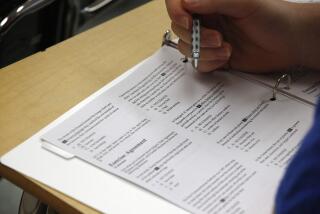Jerry Brown should spare CALPADS
For better or worse, and there’s some of both, this is the age of measurement in education. Yearly state standards tests, high school exit exams, dropout rates, truancy rates — a dizzying amount of data surrounds the modern school experience. Yet California, finally on the verge of being able to put all this into a coherent form that allows the state to track individual students’ progress, might pull back.
Gov. Jerry Brown has proposed cutting from the budget the $8.5 million it would take to complete the California Longitudinal Pupil Achievement Data System, or CALPADS, which would track each student from kindergarten through 12th grade and possibly beyond, as well as a related system for teachers. He’s not doing so because of the money — the system is paid for with federal dollars — but because of his concern that too much standardized testing is going on and his expressed belief that school districts should do this on their own.
The latter argument reflects an outdated idea of student demographics. These days, many students don’t stay in the same school district for long. In L.A. Unified alone, more than a fourth of students move during any given school year, sometimes within the district, sometimes not. And what about students who transfer to charter schools, and then graduate from those to other charter schools?
CALPADS has other benefits beyond merely tracking individual students. It would allow statisticians to compile a wealth of information that could help shape instruction and educational policy. Are students who can’t do multiplication in third grade the most likely to drop out? Which programs actually help students? The system would streamline food-stamp eligibility and other school record-keeping. Most states are far ahead of California on this issue.
Brown is right to have concerns about the standardized tests. As we’ve said before, the yearly state tests aren’t very good. The material they cover is broad and shallow; they require far too little in the way of analytical and writing skills; they repeat so many rote questions year to year that some teachers prepare their students, quite effectively, with practice exams that repeat the questions from previous years’ tests.
So we agree with Brown’s decision this month to align California with a consortium of states and educators that plans to adopt a more flexible testing approach, with more meaningful test questions and more teacher involvement. Fixing the tests is the right solution, not leaving the state in the dark — and the Dark Ages — when it comes to helpful pupil data. The Legislature is expected to restore CALPADS’ funding in the budget, and Brown should keep it there.
More to Read
A cure for the common opinion
Get thought-provoking perspectives with our weekly newsletter.
You may occasionally receive promotional content from the Los Angeles Times.






